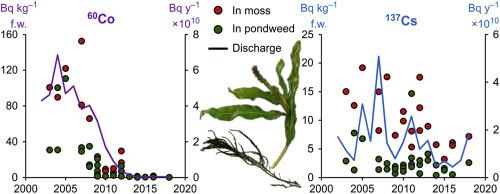Journal of Environmental Radioactivity ( IF 2.3 ) Pub Date : 2020-11-20 , DOI: 10.1016/j.jenvrad.2020.106461 Tatiana Zotina , Dmitry Dementyev , Yuliyana Alexandrova

|
Long-term trends of artificial radionuclides, from 2003 to 2018, in two abundant species of macrophytes, shining pondweed, Potamogeton lucens, and water moss, Fontinalis antipyretica, have been analyzed to estimate the indicative reliability of these two species as biomonitors of radioactive contamination in a river system and to quantify the decrease in the content of artificial radionuclides in the Yenisei River. Time-dependent trends of artificial radionuclides in the biomass of these species were similar, resulting in estimates of effective half-lives for 54Mn, 58Co, 60Co, 65Zn, 137Cs, and 152Eu similar for both species. Concentrations of artificial radionuclides in biomass of shining pondweed and water moss correlated with annual discharges of the radionuclides to the Yenisei at different levels of significance, and the strongest (R2 > 0.7) positive correlation (p < 0.05) was obtained for 60Co, 65Zn, and 152Eu. Concentrations of 60Co, 137Cs, and 152Eu in water moss were 2–7.5 times higher than in shining pondweed, and considerable percentages of those isotopes were recorded in extracellular particulate matter, which was largely represented by epiphytic diatoms. Higher concentrations of artificial radionuclides in the biomass of water moss can be considered as an advantage of water moss as a monitor of radioactive contamination of the Yenisei, while shining pondweed is more useful for estimation of annual deposits of radionuclides in vegetation of the Yenisei and spatial transfer of radionuclides downstream of the discharge site. Despite differences in concentrations of artificial radionuclides, both species can be considered as reliable indicators of radioactive contamination of the river on a long-term scale.
中文翻译:

叶尼塞河两大水生植物中人工放射性核素的长期趋势和形态:透明质酸钾和枫香抗热菌的比较研究
长期人工放射性核素的趋势,从2003年到2018年,在水生植物两个物种丰富,闪耀眼子菜,光叶眼子菜,水苔藓,鲑antipyretica,进行了分析,以评估这两个品种的指示可靠性放射性污染的生物监测并量化叶尼塞河中人工放射性核素含量的减少。这些物种生物量中人工放射性核素的时间依赖性趋势相似,从而得出了54 Mn,58 Co,60 Co,65 Zn,137 Cs和152的有效半衰期的估计值。两种物种的相似。发光的藻类和水苔生物量中的人工放射性核素浓度与放射性核素向叶尼塞河的年度排放量在不同的显着性水平上 相关,对于60 Co,最强的(R 2 > 0.7)正相关性(p <0.05),65 Zn和152 Eu。60 Co,137 Cs和152的浓度水生苔藓中的Eu比闪亮的藻类中的Eu高出2–7.5倍,并且这些同位素中有相当大的百分比记录在细胞外颗粒物中,其中大部分以附生硅藻为代表。水苔生物量中较高浓度的人工放射性核素可被视为水苔的一个优势,可以作为叶尼塞河放射性污染的监测器,而光辉的藻草对于估算叶尼塞河植被中的放射性核素年沉积量和空间分布更为有用。放射性核素在放电位点下游的转移。尽管人工放射性核素的浓度存在差异,但从长远来看,这两种物种都可以视为河流放射性污染的可靠指标。


























 京公网安备 11010802027423号
京公网安备 11010802027423号